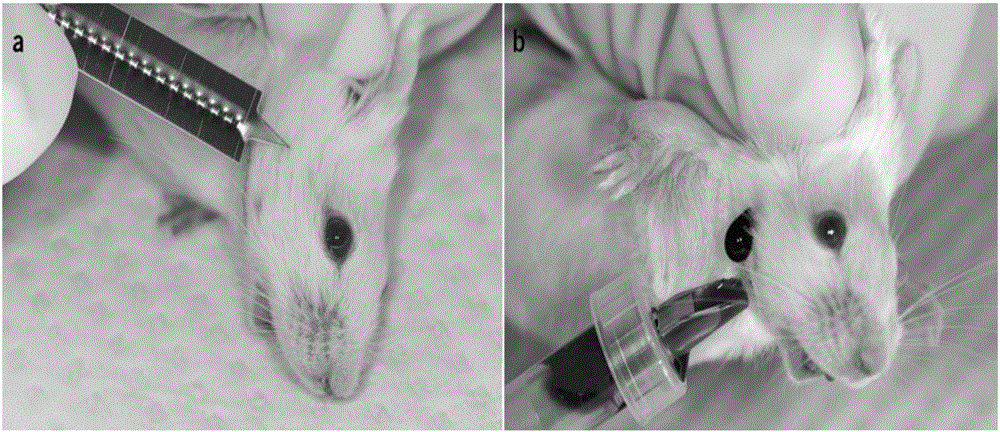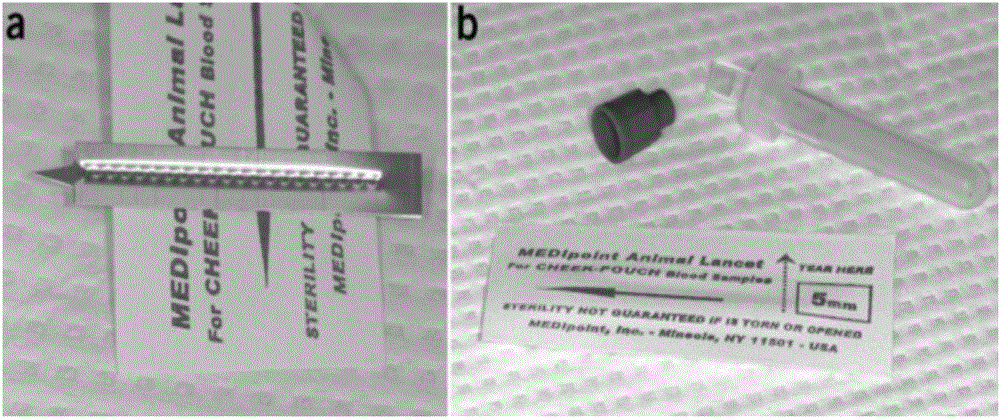Mouse submandibular venous blood collecting method
A mouse and vein technology, applied in medical science, veterinary instruments, sensors, etc., can solve the problems of high difficulty in operation, animal death, easy blood coagulation, etc., and achieve short blood collection time, simple experimental equipment, and easy operation The effect of simple method
- Summary
- Abstract
- Description
- Claims
- Application Information
AI Technical Summary
Problems solved by technology
Method used
Image
Examples
Embodiment 1
[0027] On the sterile operating platform, select a medical lancet with a blade length of 4mm, fix the 25g mouse with one hand, and wipe the blood collection site with an alcohol cotton ball with the other hand. figure 2 As shown in a, the lancet is quickly and vertically inserted at the blood collection site, and the blood collection site is as shown in figure 1 As shown, the depth is the length of the cutter head 4mm, after inserting the cutter head, turn the cutter head 90° clockwise, pull out the cutter head, the blood flows out as shown in the figure figure 2 As shown in b, use a centrifuge tube to catch a blood drop of 0.5 mL at the blood collection site. Press the bleeding point with a dry cotton ball for 60s. When there is no bleeding, the blood collection is completed. Lancets and centrifuge tubes for blood collection such as image 3 a and image 3 b shown. After blood collection, the mice were Figure 4 shown.
Embodiment 2
[0029] On the sterile operating platform, select a medical lancet with a length of 5mm, fix the 30g mouse with one hand, wipe the blood collection site with an alcohol cotton ball with the other hand, and use the lancet to quickly verticalize the blood collection site. Puncture, blood collection site such as figure 1 As shown in the figure, the depth is the length of the cutter head, 5 mm. After the cutter head is inserted, turn the cutter head 90° clockwise, pull out the cutter head, and the blood flows out. Use a centrifuge tube to catch 0.6 mL of blood drop at the blood collection site. Press the bleeding point with a dry cotton ball for 40s. When there is no bleeding, the blood collection is completed.
Embodiment 3
[0031] Using the blood collection method of Example 1, the blood collection was performed 10 times, and the blood collection time for each mouse was about 35-45 s, and the whole process of single blood collection for a mouse could be completed in an average of (50±8) s each time. Skilled experimental personnel can complete the blood collection process in a shorter time. The invention uses the submandibular vein blood collection method to perform blood collection operations on 10 male and female mice, the blood collection volume of each mouse ranges from 0.38 to 0.6 mL, and the average blood collection volume of each mouse can reach (0.38±1.58 mL). All experimental mice survived normally, the blood collection time was short, and the blood collection operation had no effect on the behavior and spirit of the mice, and the mice could quickly return to an active state; the blood sample collection volume was large.
[0032] The blood collection method of the present invention is com...
PUM
 Login to View More
Login to View More Abstract
Description
Claims
Application Information
 Login to View More
Login to View More - R&D
- Intellectual Property
- Life Sciences
- Materials
- Tech Scout
- Unparalleled Data Quality
- Higher Quality Content
- 60% Fewer Hallucinations
Browse by: Latest US Patents, China's latest patents, Technical Efficacy Thesaurus, Application Domain, Technology Topic, Popular Technical Reports.
© 2025 PatSnap. All rights reserved.Legal|Privacy policy|Modern Slavery Act Transparency Statement|Sitemap|About US| Contact US: help@patsnap.com



